- Home
- Georgette Heyer
Acting on Impulse
Acting on Impulse Read online
CONTENTS
ACTING ON IMPULSE
Contemporary Short Stories
by
Georgette Heyer
Overlord Publishing
overlordpublishing.com
Copyright Declaration
“A Proposal to Cicely” © 1922; “The Little Lady” © 1922; “Linckes’ Great Case” © 1923; “The Bulldog and the Beast” © 1923; “Acting on Impulse” © 1923; “Whose Fault Was It?” © 1923; “The Chinese Shawl” © 1923; “Love” © 1923; “The Old Maid” © 1925
Additional materials © 2019 by Jennifer Kloester and Rachel Hyland.
Georgette Heyer’s Bibliography courtesy Jennifer Kloester.
All rights reserved. No part of this book may be used or reproduced in in any manner whatsoever without written permission, except in the case of brief quotations embodied in critical articles or reviews.
Overlord Publishing. As was foretold.
Check overlordpublishing.com for news of our other exciting releases.
1 2 3 4 5 6 7 8 9 10
With thanks to Ruth Williamson,
for unmatched attention to detail.
~
For Georgette, forever and always.
CONTENTS
INTRODUCTION
“A PROPOSAL TO CICELY”
INTRODUCTION
A PROPOSAL TO CICELY
READING “A PROPOSAL TO CICELY”
“THE LITTLE LADY”
INTRODUCTION
THE LITTLE LADY
READING “THE LITTLE LADY”
“LINCKES’ GREAT CASE”
INTRODUCTION
LINCKES’ GREAT CASE
READING “LINCKES’ GREAT CASE”
“THE BULLDOG AND THE BEAST”
INTRODUCTION
THE BULLDOG AND THE BEAST
READING “THE BULLDOG AND THE BEAST”
“ACTING ON IMPULSE”
INTRODUCTION
ACTING ON IMPULSE
READING “ACTING ON IMPULSE”
“WHOSE FAULT WAS IT?”
INTRODUCTION
WHOSE FAULT WAS IT?
READING “WHOSE FAULT WAS IT?”
“THE CHINESE SHAWL”
INTRODUCTION
THE CHINESE SHAWL
READING “THE CHINESE SHAWL”
“THE OLD MAID”
INTRODUCTION
THE OLD MAID
READING “THE OLD MAID”
“LOVE”
INTRODUCTION
LOVE
READING “LOVE”
THE SEARCH FOR “ON SUCH A NIGHT”
GEORGETTE HEYER’S BIBLIOGRAPHY
FURTHER READING
INTRODUCTION
BY JENNIFER KLOESTER
I began my Georgette Heyer research journey in May 1999 with my first visit to the wonderful British Library. Arriving at King’s Cross Station (itself a name to conjure with!) and walking the short distance to the library, receiving a Reader’s Pass and gaining access to the reading rooms in that amazing building was, to me, akin to winning a Golden Ticket and being admitted to Willy Wonka’s Chocolate Factory. I was awe-struck by the King’s Library housed in its magnificent multi-storey glass tower at the top of the stairs and by the beautiful Rare Books and Music reading room where, over the next ten years, I would spend so many happy hours pursuing all things Heyer. I’ll never forget being allowed to take possession of Domenico Angelo’s School of Fencing, published in 1787, and spending a glorious hour leafing through its pages. Heyer had used Angelo’s guide in her own research and, though I did not know it then, this first foray into understanding her life and writing would mark the beginning of what has become a twenty-year adventure (which is still ongoing).
In 2001 I began my Doctorate on Georgette Heyer and her Regency novels. In 2002 I travelled to England to meet her son, Sir Richard Rougier, her biographer, Jane Aiken Hodge, and to return to the British Library to further my research. In the first year of my Doctoral studies I had discovered the existence of several untapped archives of Heyer’s early letters and Sir Richard had generously granted me copyright permission to have access to these. It was here that I found the first clue that Georgette Heyer had written short stories in the early 1920s.
At the time, the only Heyer short stories I had seen were the eleven historical tales that made up the 1960 anthology, Pistols for Two – republished in 2016 under the title Snowdrift, and including three more historical shorts I was able to unearth – all of which had been published from 1935 onwards. However, here among the collection of her correspondence owned by the University of Tulsa was a letter in Heyer’s own hand, written to her agent just a few months after her twentieth birthday, that said: “I’ve sent you another short story, and there is a third in the making.” I was instantly intrigued. While I knew it was possible that these early short stories, sent so enthusiastically to her agent, might never have been published, I also knew that I had to find out.
The first challenge was working out where these early Heyer stories might have appeared. This was no easy task as the 1920s in England had been a Golden Age for short story writers with more fiction magazines published than at any other time. Scores of famous writers made their names writing for publications such as The Strand Magazine, Nash’s, The Happy Mag, Sovereign, The Quiver, Pall Mall, The Red Magazine and Pearson’s, among many others. Writers like Agatha Christie, P.G. Wodehouse, Richmal Crompton, J.B. Priestley, Daphne du Maurier, A.A. Milne, Sapper, and Ngaio Marsh found homes for their short fiction on a regular basis. As Mike Ashley observed in The Age of Storytellers, the 1920s would also be “the last haven of the popular fiction magazine” as the rise of radio in the 1930s saw the demand for short stories begin to decline.
If Georgette Heyer had been published in one or more of these magazines, I reasoned, then it seemed likely that these would have been historical stories. Unfortunately, this gave me no real idea of which among dozens of likely magazines might have accepted her youthful tales. Fortunately, as I read through the archive of her letters I came across a clue. In 1936, Heyer had written two historical shorts and she wrote to her agent about them: “under no circumstances should they be offered to the cheap ‘popular’ magazines such as The Red & The Happy, etc.” Here at last was a clue to at least a couple of magazines where I could start looking.
The biggest repository of UK magazines in the world is the British Library, and so I returned to that great institution and began my search for these forgotten Heyer works. One hundred and sixty microfilm reels later, I had found five short stories: three in The Happy Mag and two in the Red Magazine. It was an exhilarating experience. There is nothing like that moment when, after pages and pages and pages have been examined, suddenly – there in front of you – is Georgette Heyer’s name and above it the title of a story you have never heard of before. And then comes the thrill of reading for the first time the stories written when she was only twenty. I devoured “A Proposal to Cicely” (which was, I later discovered, republished in Mary Fahnestock-Thomas’s Georgette Heyer: A Critical Retrospective in 2001), “The Little Lady”, “The Bulldog and the Beast”, “Acting on Impulse” and “Whose Fault Was It?”. Five short stories, all set in contemporary times and each with something new to tell me about Heyer.
Of course, such finds only made me long for more, and by now I had learned from Heyer’s letters that many of her novels had been serialised in the famous British magazine, Woman’s Journal. This collection was housed at the Newspaper Library – that arm of the British Library situated at Colindale, about forty-five minutes from London on the Underground. Today, Colindale is no more, but between 2002 and 2011 I travelled there many times. Though it was something of a trek, I always looked forward t
o my visits there.
On my first visit I was somewhat taken aback by the starkness of the scene outside the station. On the opposite side of the narrow road and standing by itself like an old forgotten relative was a solid brick rectangular building. More prison than library, I thought at the time, unaware of how much affection I would have for it by the time my years of research there ended. Today, the British Library has moved its newspapers and magazines to Yorkshire. In time, I expect everything will be digitized and made available on the internet. Very convenient, of course, but I wouldn’t have missed those long days at Colindale for anything.
The kindness of the staff, the great wooden trolleys stacked with twenty huge bound volumes of magazines, the anticipation of what might lie between the thick cardboard covers, the feel and smell of the pages as I turned them, always hopeful that the next page would reveal the eagerly-sought, cherished Georgette Heyer by-line. I always arrived early, before the reading room opened, and would then wait with other keen researchers in the downstairs cloakroom. A sparse space with just a few chairs and a table and nothing at all to indicate the “cave of wonders” that lay upstairs. It was always magical to me, being at the Newspaper Library.
I visited England nine times in pursuit of information about Georgette Heyer but my time there was always limited. Three full days, five full days, seven at the most was all the time I could allow for the magazine research on any one trip. The staff at Colindale were so kind and very understanding of my situation – an Australian far from home with a clear goal and limited time in which to achieve it, and they always allowed me more than my regulated allowance of four items at one time. They would bring up a huge trolley filled with great bound books – each one holding as many as twelve magazines for me to search.
It was in these that I found “Linckes’ Great Case” and “The Old Maid,” two very different stories written two years apart. “The Old Maid” appeared under the name of “Stella Martin” – the same name under which Heyer had published her third novel, The Transformation of Philip Jettan. At first I wasn’t sure if the story was hers – after all, there could be another Stella Martin writing short stories for the magazines – but then I read the story. Definitely Heyer’s. So many things in it resonated and today it remains one of my favourites of hers. In fact, I find it nearly impossible to separate Heyer from Helen, the story’s main protagonist.
Those days at Colindale also revealed her historical short stories and serialised novels that had appeared in Woman’s Journal. Heyer was first published in that magazine in 1935 and over the years she became one of their most popular “selling” names; husbands were known to snatch the magazine from their wives’ hands if Georgette Heyer’s name was on the cover. I loved Woman’s Journal and not only because it had an index which made searching a lot quicker and easier, but also because it published so many well-known authors.
Over the years, I searched more than three thousand physical magazines, sometimes turning pages for eight hours at a time. My final reward for my (some would say obsessive) persistence came on a day when I was back at the main British Library. This is where The Sovereign Magazine was held and it was here that I found Georgette Heyer’s earliest known historical short story: the tragedy entitled “Love”. I’ll always remember the moment when I turned the page and saw the title and with her name beneath it. It was all I could do not to jump for joy right there in the Rare Books and Music Reading Room. I had to suppress a desire to shriek with excitement and did a tiny little jig instead.
My final discovery came from a typewritten list of her many publication which I found in the Heyer Archive held by her son. Here were listed the various foreign serial rights and foreign publications of her novels. Here, too, was a list of her short stories. But most of these were the historical shorts her readers would come to know from her 1960 anthology, Pistols for Two – whereas not a single one of the contemporary short stories I had discovered at the British Library was included on the list. Only one short story title from the 1920s was listed and it was not a title I had found in any of the magazines I had spent so long searching. “‘The Chinese Shawl’ 1924 Tidenskronder” was how the entry read. At the top of the page was written “Danish Serial Rights.” Another clue. I contacted the main library in Copenhagen and the remarkably efficient librarian very kindly effected a search for me and, in what seemed like no time at all, sent me the story. Of course, it was in Danish, which meant finding a translator. I eventually found two and so have two slightly more modern versions of this early Heyer short. It was only this year, and because of my collaborator Rachel Hyland’s brilliance and persistence, that the original story finally came to light in a most unlikely publication.
Of these nine short stories, seven were contemporary shorts published in a single year (September 1922 – October 1923), one was a historical short (November 1923) and one was published in 1925 under Heyer’s pseudonym. Each story tells us something about Georgette Heyer, about her development as a writer, her willingness to experiment, her ear for the language of the day, her attitudes to women and marriage, her attempts to write in different genres and her perception of love and relationships. These stories represent her juvenilia – they are not her best work, but nor are they anything of which to be ashamed. She was writing for money and for experience. She was working out her voice and trying her hand at different styles. These early stories, along with her early novels, helped build Heyer’s writing “muscle”; they were an important part of her evolution as an author. They are also interesting, entertaining stories, reflective of their time and place. Even at twenty, Georgette Heyer was a good writer, and her earliest short stories reveal much of the superb stylist she would become.
Most of the stories included in this collection have not been seen since their first publication nearly one hundred years ago. Georgette Heyer’s novels, however, continue to sell in large numbers around the world and she has become that rare thing – a perennial bestseller. Forty-five years after her death she is considered a classic author and, as her works endure and interest in Heyer continues to grow, her early short stories take on a new significance. In light of this, we wanted to make these stories available to readers everywhere and to offer an introduction and afterword to each story. The introductions place the stories in their historical and cultural context and give a sense of Heyer’s life at the time. The afterwords offer readers a modern take on the stories’ 1920s sensibilities and humorously highlight the many subtle and not-so-subtle differences between Heyer’s time and ours. Of course, each story can be enjoyed in its own right without reading the commentaries, though we hope that they will add to the reader’s enjoyment of these very early Heyer works.
“A PROPOSAL TO CICELY”
INTRODUCTION
As far as we know, “A Proposal to Cicely” was Georgette Heyer’s first published short story. It appeared in print in the English journal The Happy Mag in September 1922. Brought out by George Newnes Ltd., who also published the famous Strand Magazine, The Happy Mag was a new publication, having begun in June of that year with a particular focus on humour. A monthly magazine, it would become most famous for the “William” stories written by Richmal Crompton. Although a claim in the Age of Storytellers that the magazine had “launched the career of Georgette Heyer” is untrue – she had already had considerable success with her first novel, The Black Moth (1921) and a second novel, The Great Roxhythe, was due out in the coming November – the publication of “A Proposal to Cicely” in The Happy Mag did mark the beginning of an intensive period of short story writing for her.
Unlike her first two novels, both of which had historical settings, “A Proposal to Cicely” was her first contemporary story. It is a romantic tale which tells of Cicely and her “first cousin once removed” Richard Spalding, who wants to marry her. So far, she has refused every one of “Dicky’s” proposals and when the story opens Cicely is “absolutely sick” of everything and “ready to do something desperate.” Richard t
akes this all in good part and there follows an illuminating conversation which reveals much about the characters.
Richard is one of those men of independent means so beloved of writers. He does not have to work but has money enough to live a life of leisure. Heyer describes him as “an athlete and an amateur boxer,” but Cicely tells him “you don’t do anything,” though she does concede that he has stood for Parliament “and all that sort of thing.” When Richard mentions in passing that he spent four years in the trenches, Cicely is “slightly mollified,” though she tells him frankly, “I don’t count that”.
To the modern reader this abrupt dismissal of Richard’s war service may read oddly; to Heyer’s generation, however, it was an entirely appropriate response. She herself had been raised in an aspirational middle-class home and taught the importance of regulating one’s feelings, keeping a “stiff upper-lip” in the face of adversity, and of the need for restraint and discretion when discussing serious matters. While it is acceptable for Cicely to throw a cushion across the room, or vehemently express her distaste for modern living and complain of being bored, it would be pushing the bounds of good taste for her to discuss in detail, or properly acknowledge, Richard’s war service.
Though “A Proposal to Cicely” has less polish than her later stories and novels, she had already developed the knack of revealing character through dialogue: we quickly learn that Richard is intelligent, decent and well-bred and that Cicely is bright, impulsive and naïve. The dialogue is also an enjoyable throwback to an era when people said things like “honour bright!” “be a sport” “beastly” and “oh, rather!” When Cicely complains that she’s sick of dances, she tells Richard that she’s “been trotted round till I want to scream!”

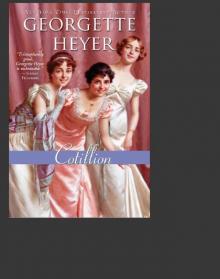 Cotillion
Cotillion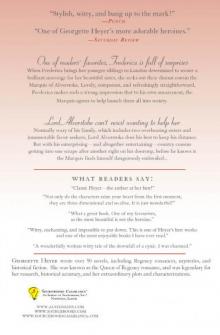 Frederica
Frederica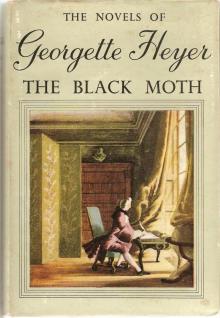 The Black Moth: A Romance of the XVIIIth Century
The Black Moth: A Romance of the XVIIIth Century Lady of Quality
Lady of Quality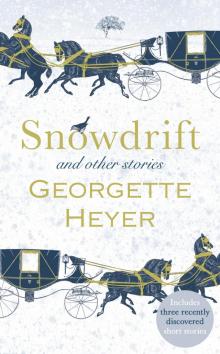 Snowdrift and Other Stories
Snowdrift and Other Stories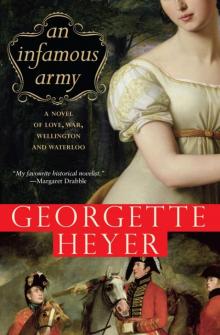 An Infamous Army
An Infamous Army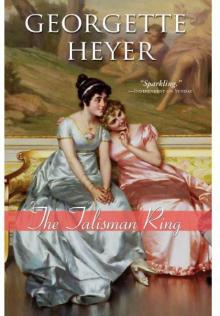 The Talisman Ring
The Talisman Ring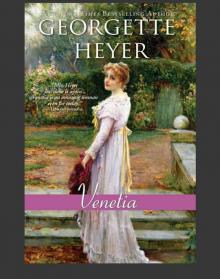 Venetia
Venetia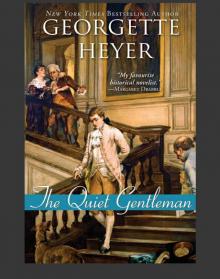 The Quiet Gentleman
The Quiet Gentleman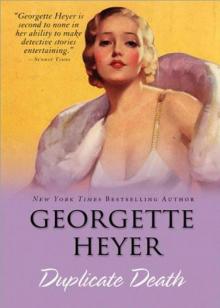 Duplicate Death
Duplicate Death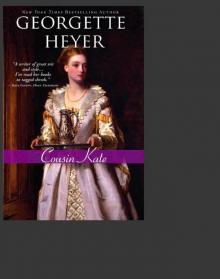 Cousin Kate
Cousin Kate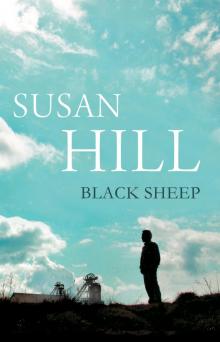 Black Sheep
Black Sheep Pistols for Two
Pistols for Two Sprig Muslin
Sprig Muslin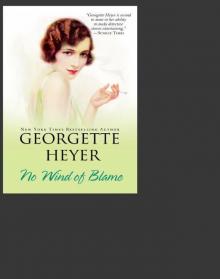 No Wind of Blame
No Wind of Blame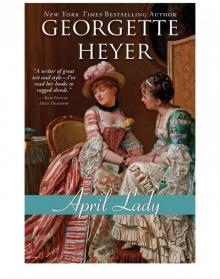 April Lady
April Lady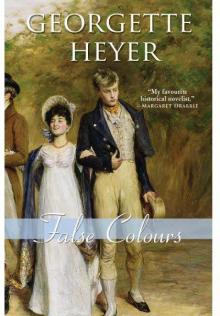 False Colours
False Colours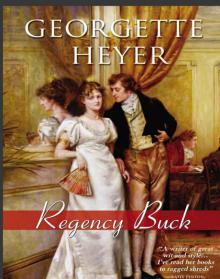 Regency Buck
Regency Buck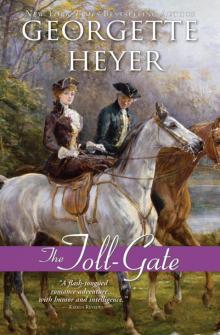 The Toll-Gate
The Toll-Gate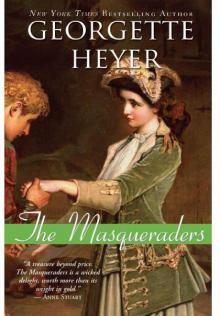 The Masqueraders
The Masqueraders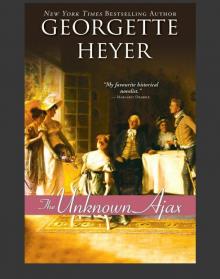 The Unknown Ajax
The Unknown Ajax The Grand Sophy
The Grand Sophy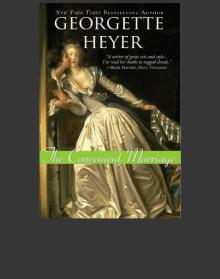 The Convenient Marriage
The Convenient Marriage Faro's Daughter
Faro's Daughter The Conqueror
The Conqueror The Foundling
The Foundling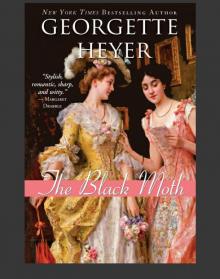 The Black Moth
The Black Moth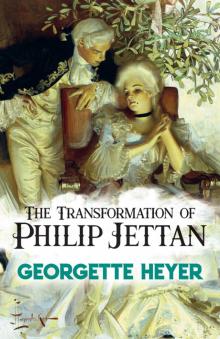 The Transformation of Philip Jettan
The Transformation of Philip Jettan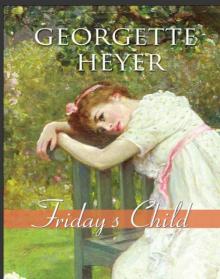 Friday's Child
Friday's Child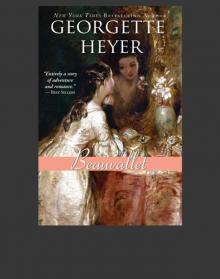 Beauvallet
Beauvallet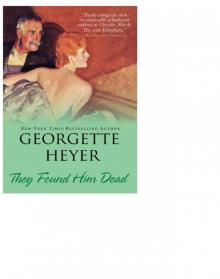 They Found Him Dead
They Found Him Dead Charity Girl
Charity Girl Death in the Stocks: Merely Murder
Death in the Stocks: Merely Murder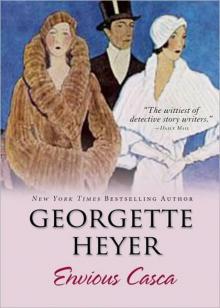 Envious Casca
Envious Casca Behold, Here's Poison
Behold, Here's Poison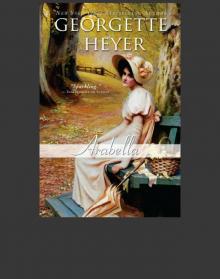 Arabella
Arabella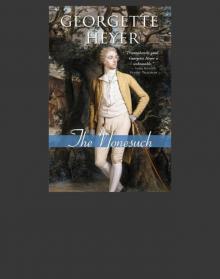 The Nonesuch
The Nonesuch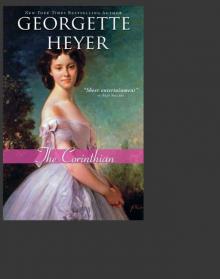 The Corinthian
The Corinthian Jennifer Kloester
Jennifer Kloester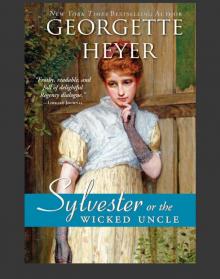 Sylvester
Sylvester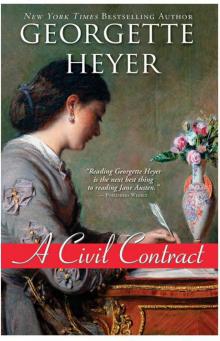 A Civil Contract
A Civil Contract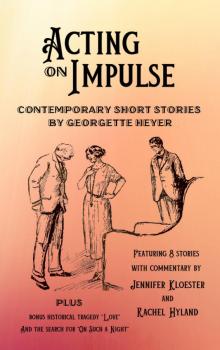 Acting on Impulse
Acting on Impulse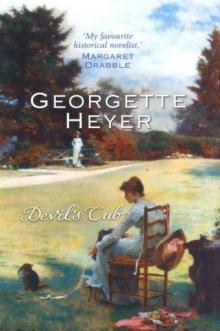 Devil’s Cub at-2
Devil’s Cub at-2 Black Moth
Black Moth Grand Sophy
Grand Sophy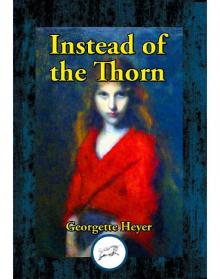 Instead of the Thorn
Instead of the Thorn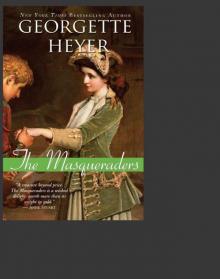 Masqueraders
Masqueraders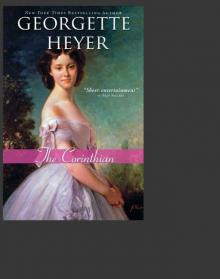 Corinthian
Corinthian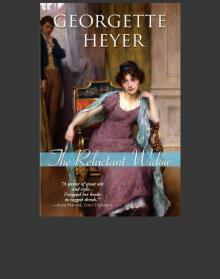 Reluctant Widow
Reluctant Widow